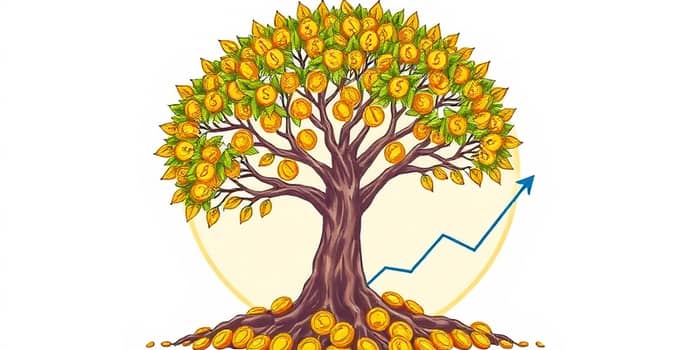Dividend investing offers a unique pathway to build sustainable, long-term wealth by combining steady income with the potential for capital appreciation. For investors seeking both security and growth, dividends represent a powerful tool to navigate market cycles and benefit from compounding returns.
In this article, we delve into the rationale behind dividend investing, explore core strategies, examine essential metrics, and provide actionable guidance to craft a robust portfolio. Whether you are approaching retirement or looking to enhance your existing investments, these insights will help you achieve financial resilience.
Why Dividend Investing Matters
Dividends are periodic payments made by companies to shareholders, reflecting a portion of profits returned as cash. Beyond the immediate appeal of receiving regular checks, dividends play a central role in wealth accumulation over decades.
Here’s why this approach resonates with savvy investors:
- A reliable income stream that cushions against market volatility and offers predictable cash flow.
- Compounding power via reinvestment that amplifies returns as dividends purchase additional shares.
- Inflation-beating dividend growth provided by companies with a track record of increasing payouts.
- Lower historical drawdowns compared to non-dividend payers in bear markets.
Core Strategies for Dividend Investors
Crafting a dividend portfolio involves balancing income, growth, and risk. Here are the primary approaches:
- Dividend Growth Investing: Focus on companies that have raised dividends for decades, such as Dividend Aristocrats, signaling financial health and management commitment.
- High-Yield Investing: Target firms offering yields above 4–5%, delivering elevated current income but requiring careful analysis to avoid unsustainable payouts.
- Blended/Total Return Approach: Combine growth-oriented and high-yield stocks to balance capital appreciation with income generation.
Beyond stock selection, many investors leverage dividend-focused ETFs to gain diversified exposure with lower costs and simplified management.
Key Metrics and Due Diligence
Rigorous analysis is critical to ensure dividends are sustainable over the long term. Consider these core metrics:
In addition to these quantitative checks, assess qualitative factors such as debt levels, profit margins, and industry positioning. A strong balance sheet and consistent earnings are hallmarks of companies that can weather economic downturns.
The Amplifying Power of Compound Growth
Reinvesting dividends accelerates wealth creation through compounding. Historically, reinvested dividends accounted for nearly half of the total S&P 500 return over the past 30 years.
For example, a $10,000 investment in the S&P 500 in 1993 would have grown to a substantially higher value by reinvesting dividends, compared with price appreciation alone. This demonstrates how patient reinvestment strategies can substantially outpace growth-only returns over time.
Strategic Portfolio Construction
Designing a dividend portfolio requires careful attention to diversification, risk tolerance, and investment horizon. Key elements include:
- Dividend growth stocks (e.g., Dividend Aristocrats) for steady increases in payouts.
- High-yield selections in utilities or REITs for enhanced current income.
- Geographic and sector diversification to cushion sector-specific downturns.
- Dividend-focused ETFs for efficient, low-cost exposure.
Allocate more to high-yield assets as retirement nears, while younger investors might emphasize dividend growth for long-term compounding.
Benefits and Potential Pitfalls
Dividend investing offers several advantages, balanced by important considerations:
- Predictable income that supports living expenses or funds future investments.
- Historical resilience in market downturns, since dividends can offset price declines.
- Reduced volatility due to regular cash flows.
- Tax implications: dividend income is taxable, though qualified dividends may receive favorable rates.
- Risk of “dividend traps” when yields spike due to deteriorating business fundamentals.
- Possibility of slower growth compared to pure growth stocks in bull markets.
Best Practices for Ongoing Success
To maximize the benefits of dividend investing, adopt these habits:
- Regularly monitor your holdings’ payout ratios, coverage, and cash flow metrics.
- Reinvest dividends automatically through DRIPs or manual redeployment to harness compounding.
- Review sector allocations to ensure balanced exposure and mitigate concentration risk.
- Utilize tax-advantaged accounts like IRAs or 401(k)s for dividend-generating assets when possible.
- Stay informed on macroeconomic trends that may impact interest rates and corporate earnings.
Conclusion
Strategic dividend investing blends the security of regular income with the growth potential of the equity markets. By focusing on high-quality companies, diligent metric analysis, and disciplined reinvestment, investors can build a robust portfolio that delivers both stability and long-term appreciation.
Whether you seek to fund retirement, generate passive income, or preserve capital through market cycles, the principles outlined here will help you harness dividends as a core component of your wealth-building strategy.
References
- https://www.vaneck.com/us/en/blogs/income-investing/how-to-develop-a-dividend-investing-strategy-a-comprehensive-guide/
- https://www.investopedia.com/articles/basics/11/due-dilligence-on-dividends.asp
- https://digital.fidelity.com/prgw/digital/msw/details/DividendIncome
- https://www.youtube.com/watch?v=XptO9EglhZw
- https://www.tsinetwork.ca/daily-advice/dividend-stocks/successful-long-term-dividend-investing-strategies-can-add-significantly-to-your-gains-over-time/
- https://www.home.saxo/learn/guides/financial-literacy/how-dividends-work-a-comprehensive-guide-to-dividend-investing
- https://realinvestmentadvice.com/resources/blog/dividend-investing-strategy/










